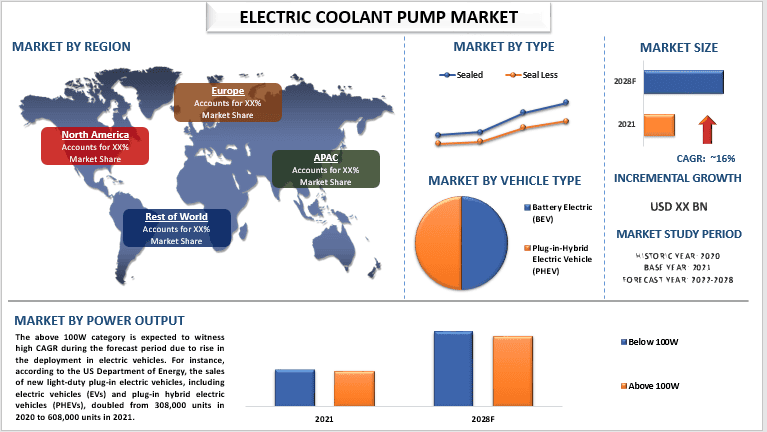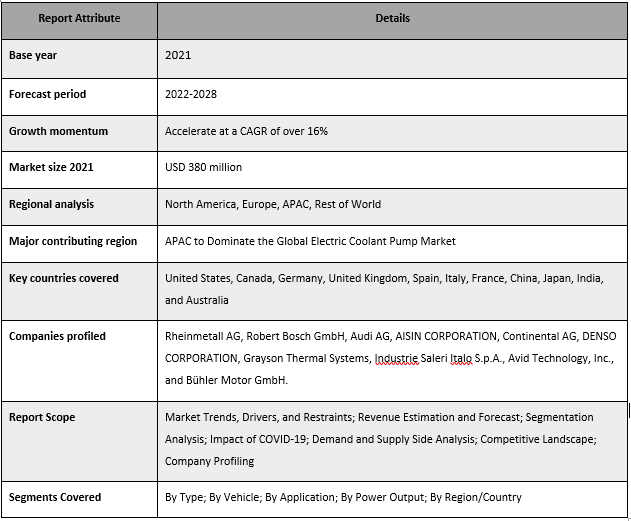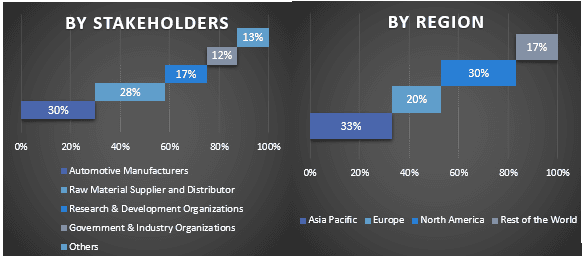
预计全球电动冷却液泵市场在 2022-2028 年预测期内将以约 16% 的显著速度增长。如今,道路上的大多数车辆都使用机械驱动的冷却液泵,该泵被认为是发动机为泵提供动力的传统冷却系统。然而,随着技术的进步,各公司推出了电动冷却液泵。充满活力的汽车行业和快速发展的创新是推动全球电动冷却液泵市场的动力。由于汽车行业在技术上的不断进步,用电子元件取代机械零件使该行业受益。由于对减少车辆排放的需求不断增长,制造商被迫使用尖端技术来制造动力总成部件。机械部件的快速电气化将因此加速乘用车电动冷却液泵市场的增长。
Rheinmetall AG、Robert Bosch GmbH、Audi AG、AISIN CORPORATION、Continental AG、DENSO CORPORATION、Grayson Thermal Systems、Industrie Saleri Italo S.p.A.、Avid Technology, Inc. 和 Bühler Motor GmbH 是市场中的一些主要参与者。这些参与者已经进行了多次并购以及合作,以向客户提供高科技和创新产品/技术。
报告中提出的见解
“在类型展望中,无密封类别将在 2021 年占据市场主导份额”
根据类型,市场分为密封式和无密封式。2021 年,由于原始设备制造商 (OEM) 对它们的强烈偏好,无密封类别占据了市场的大部分份额。影响无密封泵受欢迎程度的主要因素是许多技术优势,例如它们提供的小泄漏和更高的效率。此外,无密封泵是电动汽车的不错选择,因为它们的工作温度低于 ICE 车辆。因此,随着电动汽车销量的增加,预计无密封泵的市场在未来将会增长。预计其扩张也将受到无密封泵技术的持续研究和进步的推动。
“在车辆中,BEV 类别在预测期内将见证更高的复合年增长率”
根据车辆类型,市场分为电池电动汽车 (BEV) 和插电式混合动力电动汽车 (PHEV)。由于主要参与者增加了对开发先进 BEV 电池解决方案的投资,预计 BEV 类别在预测期内将实现较高的复合年增长率。例如,在 2021 年 10 月,Tesal 宣布在其所有标准系列的电动汽车中使用磷酸铁锂 (LFP) 正极电池,以提高其利润率。这些电池具有更长的预期寿命,无需维护且重量轻,因此对细分市场增长具有积极影响。
电动冷却液泵市场报告覆盖范围

“在功率输入中,低于 100W 类别将在 2021 年占据市场主导份额”
根据功率输出,市场分为低于 100W 和高于 100W。由于对辅助冷却用途的需求激增,低于 100W 类别在 2021 年占据了市场的主导份额。此外,各种产品的可用性也在推动细分市场的增长。例如,Robert Bosch 无刷电动冷却液泵 PCE 2.0 采用模块化设计,并提供 40、60、80 和 100 W 四种额定功率,以满足冷却液回路的不同需求。
“欧洲将在市场中占据重要份额”
2021 年,由于电动汽车销量增加以及政府为促进该地区电动汽车发展而采取的举措,欧洲在全球电动冷却液泵市场中占据了重要份额。例如,欧盟委员会已注入约 7935.9 亿美元的刺激计划,其中包括 211.6 亿美元,以促进清洁汽车的销售。因此,政府为加速生产和提高清洁汽车的意识而采取的越来越多的举措是推动电动汽车需求的主要因素,从而推动了对电动冷却液泵的需求。
购买此报告的理由:
- 该研究包括经过认证的主要行业专家验证的市场规模和预测分析。
- 该报告以一目了然的方式快速回顾了整体行业表现。
- 该报告深入分析了杰出的行业同行,主要关注关键业务财务、产品组合、扩张战略和最新发展。
- 详细检查行业中存在的驱动因素、制约因素、关键趋势和机遇。
- 该研究全面涵盖了跨不同细分市场的市场。
- 对该行业的深入区域层面的分析。
定制选项:
全球电动冷却液泵市场可以根据要求或任何其他细分市场进一步定制。 除此之外,UMI 了解到您可能有自己的业务需求,因此请随时与我们联系以获取完全适合您要求的报告。
目录
电动冷却泵市场分析(2022-2028)的研究方法
分析历史市场、评估当前市场以及预测全球电动冷却泵市场的未来市场是创建和分析全球主要地区电动冷却泵应用情况所采取的三个主要步骤。进行了详尽的二级研究,以收集历史市场数据并评估当前市场规模。其次,为了验证这些见解,考虑了大量的发现和假设。此外,还与全球电动冷却泵市场价值链中的行业专家进行了详尽的初步访谈。在通过初步访谈对市场数据进行假设和验证后,我们采用了自上而下/自下而上的方法来预测完整的市场规模。此后,采用市场细分和数据三角剖分方法来评估和分析行业相关细分市场和子细分市场的市场规模。详细方法如下所述:
历史市场规模分析
第1步:深入研究二级来源:
进行了详细的二级研究,通过公司内部来源(如年度报告和财务报表、业绩演示文稿、新闻稿等)以及外部来源(包括期刊、新闻和文章、政府出版物、竞争对手出版物、行业报告、第三方数据库和其他可信出版物)获取电动冷却泵市场的历史市场规模。
第2步:市场细分:
在获得电动冷却泵市场的历史市场规模后,我们进行了详细的二级分析,以收集主要地区不同细分市场和子细分市场的历史市场见解和份额。报告中包含的主要细分市场包括类型、车辆、应用和功率输出。此外,还进行了国家层面的分析,以评估测试模型在该地区的总体应用情况。
第3步:因素分析:
在获得不同细分市场和子细分市场的历史市场规模后,我们进行了详细的因素分析,以评估电动冷却泵市场的当前市场规模。此外,我们使用因变量和自变量(如电动冷却泵的各种类型、车辆、应用和功率输出)进行了因素分析。我们对需求和供应侧情景进行了彻底分析,考虑了全球电动冷却泵市场领域的顶级合作伙伴关系、并购、业务扩张和产品发布。
当前市场规模评估与预测
当前市场规模评估:基于以上3个步骤的可行性见解,我们得出了当前市场规模、全球电动冷却泵市场的关键参与者以及各细分市场的市场份额。所有必需的百分比份额拆分和市场细分均使用上述二级方法确定,并通过初步访谈进行了验证。
评估与预测:对于市场评估和预测,权重被分配给不同的因素,包括驱动因素和趋势、制约因素以及利益相关者可获得的机会。在分析了这些因素之后,应用相关的预测技术,即自上而下/自下而上的方法,以得出全球主要市场中不同细分市场和子细分市场的2028年市场预测。用于评估市场规模的研究方法包括:
- 该行业的市场规模,就收入(美元)以及国内主要市场中电动冷却泵市场的采用率而言
- 市场细分和子细分的所有百分比份额、拆分和细分
- 全球电动冷却泵市场中关键参与者提供的产品。此外,这些参与者为在快速增长的市场中竞争而采取的增长策略
市场规模和份额验证
初步研究:与主要地区的关键意见领袖(KOL)(包括高层管理人员(CXO/VP、销售主管、营销主管、运营主管、区域主管、国家主管等))进行了深入访谈。然后对初步研究结果进行总结,并进行统计分析以证明所陈述的假设。初步研究的投入与二级研究结果合并,从而将信息转化为可行的见解。
不同地区主要参与者的构成`

市场工程
采用数据三角剖分技术来完成整体市场评估,并得出全球电动冷却泵市场每个细分市场和子细分市场的精确统计数字。在研究了全球电动冷却泵市场中产品、类型前景、应用和最终用途领域的各种参数和趋势后,将数据分为几个细分市场和子细分市场。
全球电动冷却泵市场研究的主要目标
研究中明确指出了全球电动冷却泵市场的当前和未来市场趋势。投资者可以获得战略见解,以将其投资判断建立在研究中进行的定性和定量分析之上。当前和未来市场趋势决定了区域层面市场的整体吸引力,为行业参与者提供了一个利用未开发市场以从先行者优势中受益的平台。研究的其他定量目标包括:
- 分析电动冷却泵市场当前和预测的市场规模,就价值(美元)而言。此外,分析不同细分市场和子细分市场的当前和预测的市场规模
- 研究中的细分市场包括类型、车辆、应用和功率输出领域。
- 定义和分析电动冷却泵行业的监管框架。
- 分析涉及各种中介机构的价值链,并分析行业的客户和竞争对手行为。
- 分析主要地区电动冷却泵市场当前和预测的市场规模。
- 报告中研究的主要国家/地区包括亚太地区、欧洲、北美和世界其他地区。
- 电动冷却泵市场的公司简介以及市场参与者为在快速增长的市场中维持生存而采取的增长策略
- 深入的行业区域层面分析
相关 报告
购买此商品的客户也购买了










